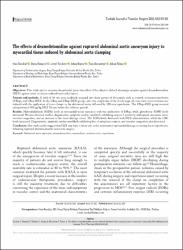| dc.contributor.author | Karakişi, Sedat Ozan | |
| dc.contributor.author | Hemşinli, Doğuş | |
| dc.contributor.author | Tümkaya, Levent | |
| dc.contributor.author | Ergene, Şaban | |
| dc.contributor.author | Mercantepe, Tolga | |
| dc.contributor.author | Yılmaz, Adnan | |
| dc.date.accessioned | 2023-02-09T07:03:05Z | |
| dc.date.available | 2023-02-09T07:03:05Z | |
| dc.date.issued | 2021 | en_US |
| dc.identifier.citation | Karakişi, O., Hemşinli, D., Tümkaya, L., Ergene, Ş., Mercantepe, T., & Yılmaz, A. (2021). The effects of dexmedetomidine against ruptured abdominal aortic aneurysm injury to myocardial tissue induced by abdominal aortaclamping. Turkish journal of vascular surgery, 30(2), 93-101. http://doi.org/10.9739/tjvs.2021.986 | en_US |
| dc.identifier.issn | 2667-5080 | |
| dc.identifier.uri | http://doi.org/10.9739/tjvs.2021.986 | |
| dc.identifier.uri | https://hdl.handle.net/11436/7546 | |
| dc.description.abstract | Objectives: This study aims to examine the potential protective effect of the selective alpha-2 adrenergic receptor agonist dexmedetomidine
(DEX) against aortic occlusion-induced myocardial injury.
Patients and methods: A total of 30 rats were randomly assigned into three groups of 10 animals each as control, ischemia+reperfusion
(I/Rep), and I/Rep+DEX. In the I/Rep and I/Rep+DEX groups, after the completion of the shock stage, 60-min lower torso ischemia was
induced with the application of cross-clamps to the abdominal aorta, followed by 120-min reperfusion. The I/Rep+DEX group received
intraperitoneal 100 µg/kg DEX 30 min before the ischemia period.
Results: Malondialdehyde (MDA) levels in myocardial tissue increased with the application of I/Rep, while glutathione (GSH) levels
decreased. We also observed swollen, degenerative, apoptotic cardiac myofibrils exhibiting caspase-3 positivity, widespread edematous areas,
vascular congestion, and an increase in the heart damage scores. The MDA levels decreased with DEX administration, while the GSH
levels increased. Degenerative, apoptotic cardiac myofibrils exhibiting loss of cytoplasm content, and vascular congestion also decreased.
Conclusion: Our study results suggest that DEX may have a future role in the treatment of myocardial damage occurring due to reperfusion,
following ruptured abdominal aortic aneurysm surgery. | en_US |
| dc.language.iso | eng | en_US |
| dc.publisher | Effect Publishing Agency ( EPA ) | en_US |
| dc.rights | info:eu-repo/semantics/openAccess | en_US |
| dc.subject | Abdominal aortic aneurysm | en_US |
| dc.subject | Dexmedetomidine | en_US |
| dc.subject | Myocardium | en_US |
| dc.subject | Oxidative stress | en_US |
| dc.subject | Reperfusion | en_US |
| dc.title | The effects of dexmedetomidine against ruptured abdominal aortic aneurysm injury to myocardial tissue induced by abdominal aorta clamping | en_US |
| dc.type | article | en_US |
| dc.contributor.department | RTEÜ, Tıp Fakültesi, Cerrahi Tıp Bilimleri Bölümü | en_US |
| dc.contributor.institutionauthor | Karakişi, Sedat Ozan | |
| dc.contributor.institutionauthor | Hemşinli, Doğuş | |
| dc.contributor.institutionauthor | Tümkaya, Levent | |
| dc.contributor.institutionauthor | Ergene, Şaban | |
| dc.contributor.institutionauthor | Mercantepe, Tolga | |
| dc.contributor.institutionauthor | Yılmaz, Adnan | |
| dc.identifier.volume | 30 | en_US |
| dc.identifier.issue | 2 | en_US |
| dc.identifier.startpage | 93 | en_US |
| dc.identifier.endpage | 101 | en_US |
| dc.relation.journal | Turkish journal of vascular surgery | en_US |
| dc.relation.publicationcategory | Makale - Uluslararası Hakemli Dergi - Kurum Öğretim Elemanı | en_US |


















